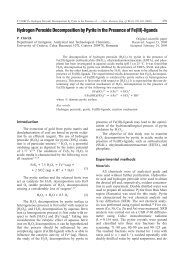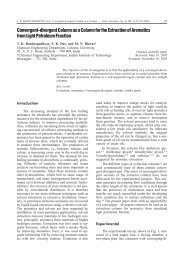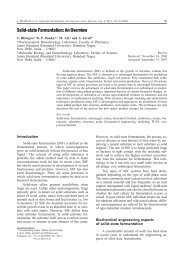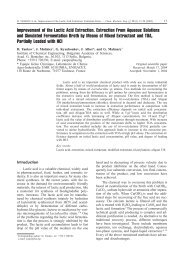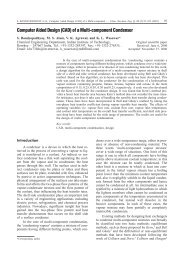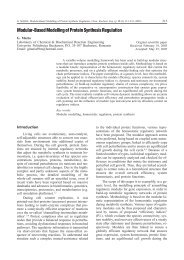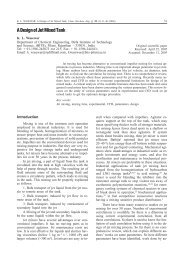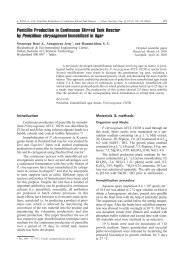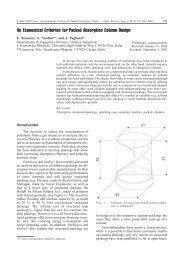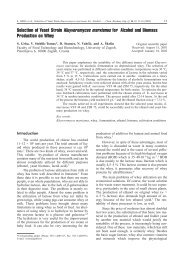Thymol Hydrogenation in Bench Scale Trickle Bed reactor - pierre
Thymol Hydrogenation in Bench Scale Trickle Bed reactor - pierre
Thymol Hydrogenation in Bench Scale Trickle Bed reactor - pierre
You also want an ePaper? Increase the reach of your titles
YUMPU automatically turns print PDFs into web optimized ePapers that Google loves.
J. DUDAS et al., <strong>Thymol</strong> <strong>Hydrogenation</strong> <strong>in</strong> <strong>Bench</strong> <strong>Scale</strong> <strong>Trickle</strong> <strong>Bed</strong> Reactor, Chem. Biochem. Eng. Q. 19 (3) 255–262 (2005) 259<br />
Fig. 6 – Temperature profile development dur<strong>in</strong>g <strong>reactor</strong><br />
start, 13 % wt. thymol<br />
Fig. 7 – Effect of liquid flow rate on temperature profile <strong>in</strong><br />
the catalyst bed at 20 % wt. of thymol <strong>in</strong> the feed<br />
Experimental results <strong>in</strong>dicate a mov<strong>in</strong>g ‘hot<br />
zone’ <strong>in</strong> the <strong>reactor</strong> with time on stream (TOS).<br />
This <strong>in</strong>dicated that the heat of reaction is released at<br />
the <strong>reactor</strong> start up and at such a low liquid flow<br />
rate the catalytic bed is probably <strong>in</strong>sufficiently wetted<br />
and so-called ‘liquid channell<strong>in</strong>g’ (rivulets) appears<br />
<strong>in</strong> the bed, caus<strong>in</strong>g local temperature gradients.<br />
The dist<strong>in</strong>ctive exotherm after 7 h of <strong>in</strong>troduction<br />
of thymol feed mixture disappeared after 13 h.<br />
The ‘hot spot’ moved along the bed and the highest<br />
temperature (almost 350 °C) was achieved at the<br />
distance of 400 mm from the top of catalyst bed.<br />
This maximum shifted towards the end of the <strong>reactor</strong><br />
and the maximum temperature dropped to approximately<br />
220 °C. Such a high temperature<br />
causes thermal decomposition and therefore undesired<br />
products (like alkylated phenol and cyclohexanol,<br />
methane) and water appeared at the <strong>reactor</strong><br />
outlet. Steady state temperature profile was observed<br />
after 13 h. At a liquid flow rate of 0.59 kg h –1 ,<br />
the maximum temperature was observed at the beg<strong>in</strong>n<strong>in</strong>g<br />
of the bed and dropped along the <strong>reactor</strong><br />
bed gradually. The temperature difference between<br />
hot spot and mean bed value was approximately<br />
50 o C.<br />
A flat axial temperature profile is optimal for a<br />
trickle bed <strong>reactor</strong>. The temperature profile <strong>in</strong> the<br />
<strong>reactor</strong> depends on the <strong>reactor</strong>-heat<strong>in</strong>g set-up, the<br />
heat of reaction, the feed concentration, and the gas<br />
and liquid flow rates. The key question is if the<br />
trickle bed <strong>reactor</strong> can be operated adiabatically (by<br />
heat<strong>in</strong>g only the pre-heat<strong>in</strong>g section). From a practical<br />
po<strong>in</strong>t of view (trickle bed <strong>reactor</strong> start up, process<br />
scale up and control), it is very important to<br />
know the process dynamics and its parametric sensitivity.<br />
A trickle bed <strong>reactor</strong> was started us<strong>in</strong>g a menthol<br />
mixture to reach a steady state temperature profile<br />
without chemical reaction. The system dynamics<br />
was evaluated on the basis of temperature profile<br />
after the <strong>in</strong>troduction of 13 % wt. of thymol<br />
feed <strong>in</strong>to the <strong>reactor</strong>. The temperature <strong>in</strong> the catalyst<br />
bed was controlled by regulat<strong>in</strong>g the pre-heater<br />
temperature (TW3) only. Experimental temperature<br />
profiles <strong>in</strong> the upper part of catalyst bed are presented<br />
<strong>in</strong> Figure 6. A steady state temperature profile<br />
<strong>in</strong> the bench scale trickle bed <strong>reactor</strong> at thymol<br />
concentration of 13 % wt. and liquid flow rate 1.3<br />
kg h –1 can be achieved <strong>in</strong> 3 h from a change of feed<br />
<strong>in</strong>to the <strong>reactor</strong>. This was confirmed <strong>in</strong> several experiments.<br />
The effect of liquid flow rate on temperature<br />
profile was experimentally <strong>in</strong>vestigated. Typical<br />
steady state temperature profiles <strong>in</strong> the catalytic<br />
bed, for different liquid flow rates and different preheat<strong>in</strong>g<br />
zone temperatures, are presented <strong>in</strong> Figure<br />
7. The <strong>reactor</strong> temperature was controlled to ma<strong>in</strong>ta<strong>in</strong><br />
the maximum temperature <strong>in</strong> the bed below<br />
200 °C. The results <strong>in</strong>dicated that the <strong>reactor</strong> can be<br />
operated under adiabatic conditions and that the<br />
temperature profile can be controlled by means of<br />
only the pre-heater. However, at high liquid flow<br />
rates (2.85 kg h –1 , LHSV~3.7 h –1 ) the pre-heater<br />
temperature needs to be very low (low catalyst activity<br />
at temperatures below 100 °C) and temperature<br />
profile is very non-uniform, potentially hav<strong>in</strong>g<br />
a significant negative effect on the performance of<br />
the <strong>reactor</strong>.<br />
The fraction of thymol <strong>in</strong> the feed has a small<br />
effect on the axial temperature profile <strong>in</strong> trickle bed<br />
<strong>reactor</strong> at thymol massfraction below 25 % wt. (see<br />
Figure 8). The adiabatic temperature rise at these<br />
concentrations is less than 50 °C. To ma<strong>in</strong>ta<strong>in</strong> maximum<br />
temperature <strong>in</strong> the bed below 200 °C at<br />
thymol fraction above 25 % wt. requires a significant<br />
decrease <strong>in</strong> the <strong>in</strong>let temperature (pre-heater<br />
temperature TW3). The temperature rise at 100 mm<br />
from the top of the catalyst bed at 27 % wt. of<br />
thymol is more than 60 °C. The observed temperature<br />
rise at 100 mm from the top of the of catalyst<br />
bed at 35 % wt. of thymol is low because of<br />
low catalyst activity at temperatures below 100 °C.



